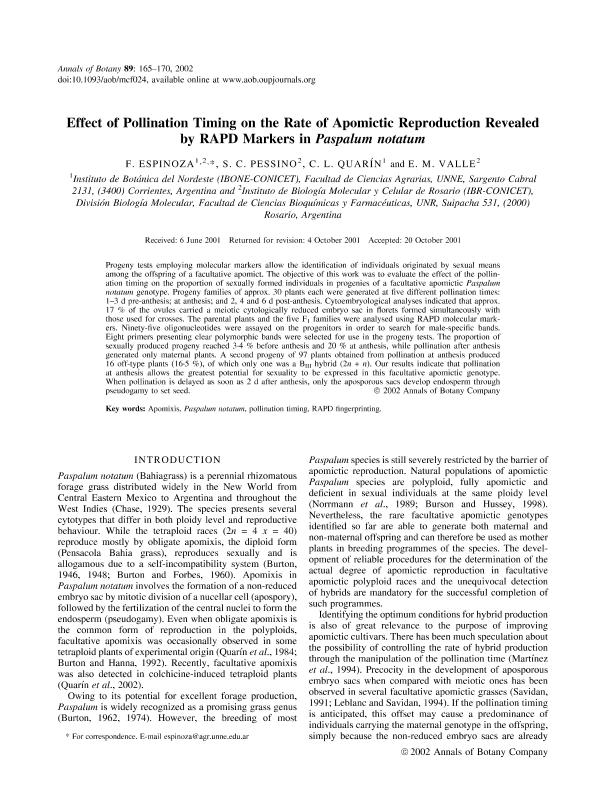Mostrar el registro sencillo del ítem
dc.contributor.author
Espinoza, Francisco

dc.contributor.author
Pessino, Silvina Claudia

dc.contributor.author
Quarin, Camilo Luis

dc.contributor.author
Valle, Estela Marta

dc.date.available
2017-12-07T17:51:28Z
dc.date.issued
2002-02
dc.identifier.citation
Espinoza, Francisco; Pessino, Silvina Claudia; Quarin, Camilo Luis; Valle, Estela Marta; Effect of Pollination Timing on the Rate of Apomictic Reproduction Revealed by RAPD Markers in Paspalum notatum; Oxford University Press; Annals of Botany; 89; 2; 2-2002; 165-170
dc.identifier.issn
0305-7364
dc.identifier.uri
http://hdl.handle.net/11336/29981
dc.description.abstract
Progeny tests employing molecular markers allow the identification of individuals originated by sexual means among the offspring of a facultative apomict. The objective of this work was to evaluate the effect of the pollination timing on the proportion of sexually formed individuals in progenies of a facultative apomictic Paspalum notatum genotype. Progeny families of approx. 30 plants each were generated at five different pollination times: 1–3 d pre‐anthesis; at anthesis; and 2, 4 and 6 d post‐anthesis. Cytoembryological analyses indicated that approx. 17 % of the ovules carried a meiotic cytologically reduced embryo sac in florets formed simultaneously with those used for crosses. The parental plants and the five F1 families were analysed using RAPD molecular markers. Ninety‐five oligonucleotides were assayed on the progenitors in order to search for male‐specific bands. Eight primers presenting clear polymorphic bands were selected for use in the progeny tests. The proportion of sexually produced progeny reached 3·4 % before anthesis and 20 % at anthesis, while pollination after anthesis generated only maternal plants. A second progeny of 97 plants obtained from pollination at anthesis produced 16 off‐type plants (16·5 %), of which only one was a BIII hybrid (2n + n). Our results indicate that pollination at anthesis allows the greatest potential for sexuality to be expressed in this facultative apomictic genotype. When pollination is delayed as soon as 2 d after anthesis, only the aposporous sacs develop endosperm through pseudogamy to set seed.
dc.format
application/pdf
dc.language.iso
eng
dc.publisher
Oxford University Press

dc.rights
info:eu-repo/semantics/openAccess
dc.rights.uri
https://creativecommons.org/licenses/by-nc-sa/2.5/ar/
dc.subject
Apomixis
dc.subject
Paspalum Notatum
dc.subject
Pollination Timing
dc.subject
Rapd Fingerprinting
dc.subject.classification
Agricultura

dc.subject.classification
Agricultura, Silvicultura y Pesca

dc.subject.classification
CIENCIAS AGRÍCOLAS

dc.title
Effect of Pollination Timing on the Rate of Apomictic Reproduction Revealed by RAPD Markers in Paspalum notatum
dc.type
info:eu-repo/semantics/article
dc.type
info:ar-repo/semantics/artículo
dc.type
info:eu-repo/semantics/publishedVersion
dc.date.updated
2017-12-04T17:29:37Z
dc.identifier.eissn
1095-8290
dc.journal.volume
89
dc.journal.number
2
dc.journal.pagination
165-170
dc.journal.pais
Reino Unido

dc.description.fil
Fil: Espinoza, Francisco. Consejo Nacional de Investigaciones Científicas y Técnicas. Centro Científico Tecnológico Conicet - Nordeste. Instituto de Botánica del Nordeste. Universidad Nacional del Nordeste. Facultad de Ciencias Agrarias. Instituto de Botánica del Nordeste; Argentina
dc.description.fil
Fil: Pessino, Silvina Claudia. Universidad Nacional de Rosario. Facultad de Ciencias Bioquímicas y Farmacéuticas; Argentina. Consejo Nacional de Investigaciones Científicas y Técnicas; Argentina
dc.description.fil
Fil: Quarin, Camilo Luis. Consejo Nacional de Investigaciones Científicas y Técnicas. Centro Científico Tecnológico Conicet - Nordeste. Instituto de Botánica del Nordeste. Universidad Nacional del Nordeste. Facultad de Ciencias Agrarias. Instituto de Botánica del Nordeste; Argentina
dc.description.fil
Fil: Valle, Estela Marta. Universidad Nacional de Rosario. Facultad de Ciencias Bioquímicas y Farmacéuticas; Argentina. Consejo Nacional de Investigaciones Científicas y Técnicas; Argentina
dc.journal.title
Annals of Botany

dc.relation.alternativeid
info:eu-repo/semantics/altIdentifier/doi/http://dx.doi.org/10.1093/aob/mcf024
dc.relation.alternativeid
info:eu-repo/semantics/altIdentifier/url/https://academic.oup.com/aob/article/89/2/165/193261
Archivos asociados
